Architectural acoustics cover two aspects, one is the sound quality of the hall, such as concert halls, theaters, theaters and other sound quality effects, on the other hand is the noise control problems in the building, such as residential, hotel, hospital, school, industrial plant, traffic trunks Sound insulation, sound absorption, vibration reduction, noise reduction and other noise reduction problems.
The main development of the hall sound quality in the design is reflected in the in-depth study of scale scale model and computer simulation. With these auxiliary design methods, the control of sound quality indicators can be made more accurate and comprehensive, such as China National Grand Theater, Guangzhou Opera House, Seoul, South Korea. The sound quality design of the world-famous halls such as the Hanjiang Music Island Concert Hall, the Copenhagen Grand Theater Center, the Hamburg Elbe Concert Hall, and the Disney Theatre in the United States all benefited from the successful application of these technologies. In 2007, China promulgated the National Standard for the Code of Practice for Hall Sound Quality Models. The simulation software developed and developed by Germany, France, Denmark, Belgium and other countries is becoming more and more accurate, and the simulation application is more and more widespread and common.
The most outstanding performance of noise control technology development is the large-scale development of new materials. For example, the gypsum board with the addition of barium sulphate filler developed by Knauf Germany can have a wall insulation of up to 70 dB, which is equivalent to the sound insulation of a concrete wall of 2 m thick and less than 1/50 of its weight. There is also a melamine sponge sound absorbing material developed by BASF Chemical Company according to the best flow resistance theory, which is much better than traditional glass wool (rock wool) and other sound absorbing materials in terms of weight reduction, dust reduction and sound absorption efficiency. Great improvement. In addition, the development of spray-type sound-absorbing insulation materials, micro-perforated sound-absorbing materials, elastic damping materials, damping damping materials, broadband multi-cavity resonance muffler is also very commendable. In addition, many new acoustic materials have been developed abroad, and new and gratifying trends have emerged in terms of aesthetics, energy saving and comprehensive functions. For example, the perforated gypsum board developed by Knauf in Germany has various hole types, beautiful appearance and even decorative effects. More than the sound absorption effect by the designer's preference. There is also a gypsum board added with phase change particles developed by Knauf, which has the traditional sound insulation effect and can also play the role of heat preservation and energy saving. The material is used as a partition wall and ceiling room, through the absorption of phase change material. The exothermic effect can reduce the indoor temperature by 2 degrees Celsius in summer. In addition, the gypsum board is matched with the lead plate to protect the room from harmful rays and electromagnetic microwave radiation, etc. These new functions combined with the traditional materials are also a major feature of the development of architectural acoustic materials. Another major technology in noise control is also very feature-active noise reduction technology, which uses a speaker to emit reverse sound waves to cancel the noise. This technology has been put into practical use in headsets and car noise reduction, and corresponding products in foreign markets have become common. In the field of architectural acoustics, due to the complexity of the sound source conditions and the uncontrollability of the on-site environment, the application is very difficult, but the research institutions at the University of Adelaide, France, the CSTB Institute of France, and the Fraunhofer Institute in Germany are in the pipeline. Research on low-frequency noise reduction and high-voltage transformer noise reduction has achieved considerable application results.
The development of architectural acoustic measurement methods is also worth mentioning. Germany, Denmark, France and other countries have developed microphone array imaging equipment, so-called acoustic cameras, which can display the opposite noise level through the color map like a camera, which will greatly facilitate the on-site diagnosis of future noise control engineering. . In addition, ISO has published an international standard for the sound absorption coefficient of sound-absorbing materials in the field. This method is more engineering than the method of measuring the sound absorption coefficient of the reverberation chamber and the standing wave tube. Sound intensity test probes developed by Germany, the United States and other countries can accurately measure the direction of sound propagation, and will be innovative for sound source localization, acoustic reflection path determination, and on-site suction and sound insulation detection.
Architectural acoustics involves a wide range of fields, including physical problems such as sound wave propagation and acoustic measurement, as well as multifaceted engineering problems such as architecture, structure, materials, and HVAC, and even psychology, behavioral science, economics, law, etc. Social integration issues, more and more experts and scholars around the world have reached a consensus, the development of regulations and standards is the key to solving the problem of architectural acoustic complexity. Therefore, nearly 20 countries in Europe have formed a cooperative body to jointly study the advantages and disadvantages of national acoustic standards and regulations. The goal is to integrate and standardize European architectural acoustic standards through international forces to fundamentally protect, maintain and promote the construction of residents. Sound environmental quality. The development of architectural acoustics standards is the driving force for the future development of architectural acoustics worldwide.
At present, China's architectural acoustics are in the ascendant, rapid economic development and huge domestic market demand, making the application of architectural acoustics grow in geometric progression. However, objectively speaking, the main support of this growth should benefit from the active application of the mature part of the building acoustic theory, technology, means and materials in engineering. As far as research is concerned, apart from the micro-perforation theory 30 years ago, basic and groundbreaking theories and techniques are still not obvious.
However, it is worth mentioning in the study of domestic architectural acoustics that there are two researches on rain noise and soundscape studies of lightweight roofs. Of course, there may be other valuable research, but it is not within my field of vision. At present, the domestic building system is becoming more and more light and light. For example, the 2008 Beijing Olympic National Swimming Center “Water Cubeâ€, the top of the wall is a membrane structure, very light, but when it rains, the raindrop noise will be very serious. Rain noise research is to solve the raindrop impact noise of this kind of lightweight roof system. There are mainly domestic research institutes of Tsinghua University. Soundscape science belongs to the combination of acoustic environment and psychology. For example, many attractions in Beijing Summer Palace, such as Suzhou Street, have been restored in antiques. Although the visual landscape has returned to the ancient feelings, what about the sound landscape? Is there noise in the ancient ring line in ancient times? In ancient times, there was a scream of a tweeter. How to protect the sound landscape is also one of the topics of sound landscape research. This type of research is mainly carried out by research institutes such as South China University of Technology.
In developed countries, the "habitat acoustic environment" of the most architectural applications, such as the United Kingdom, today requires that the residential sound insulation must reach 53dB, which means that loud shouting is simply inaudible, and our country is a developing country, housing is impossible. The cost of sound insulation is too high, and the required sound insulation is only 40dB, which is equivalent to 30-40% of people who can speak normally. It can be seen that the quality of sound environment requires a big gap. However, with the rapid development of China, people's needs will naturally increase. In order to adapt to this unstoppable historical development, in order to allow more architects to master the principles and applications of architectural acoustic design, in order to allow the wider public to have an opportunity to understand the knowledge of architectural acoustics, in order to make more quality and cheaper Acoustic materials and acoustic service providers are recognized by society, and we still need to do a lot of work.
The development of architectural acoustics in China has its own internal laws, which cannot be changed by personal wishes. However, looking at the development path of developed countries in the distance, it should be said that we can also see the clues of embarrassment. This is also the platform for me to visit and listen to the world's architectural acoustic research units through the “Friends' Forum†in 2009. One of the purposes to adapt to the trend and avoid meaningless twists and turns. Architectural acoustics is a practical science, the needs of society, and the needs of the public have promoted her progress and development. Under the severe financial crisis in the world this year, China's economic development is still so stable. The future economy is expected to be more prosperous, and the living conditions and living standards of the people will surely rise. Therefore, I believe that the development of architectural acoustics in such a large demand market in China and the current low level of the national acoustic environment, the development of its application will be leaps and bounds.
24HR Electronic timer socket with photocell.
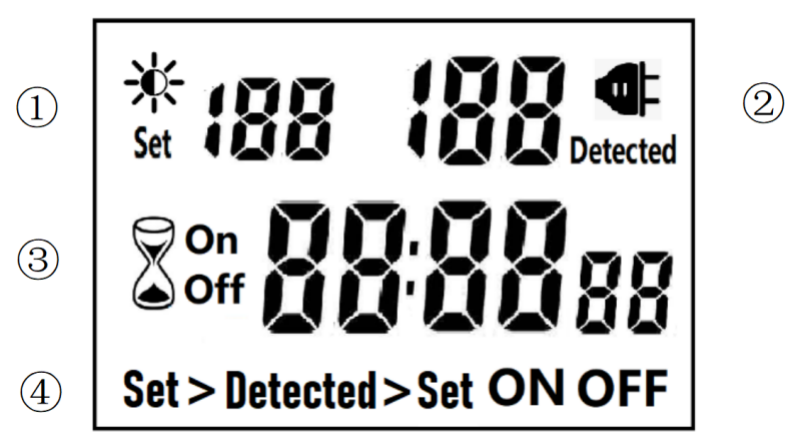
â‘ Light intensity setting
â‘¡ Light intensity detection
â‘¢ Countdown Timer ON & OFF
â‘£ 4 MODES:
Set > Detected: When the light intensity detection value is less than the set value, switch ON or OFF.
Detected > Set: When the light intensity detection value is greater than the set value, switch ON or OFF
ON : Always ON
OFF : Always OFF
NOTED:
1. The light intensity displayed by this machine is not the standard light intensity value (Lux), only the relative light intensity value.
2. The light intensity value is affected by the placement position and direction. Please determine the position first and then set it according to the actual light intensity detected. If you change the position or change the orientation, you need to reset the light intensity setting value suitable for the new position.
3. This product has built-in rechargeable battery. If it is not connected to AC for a long time, you need to connect the power supply to charge until the LCD can display normally.
MANUAL OPERATION
1. Press [UP" or [DOWN" to set the LUX value.
2. Press the [SET" key to start setting, and the P1 settable items will be flashed.
3. Press [UP" or [DOWN" to adjust the value.
4. Press [SET" key again to exit setting or enter next setting for countdown timer.
5. Repeat the [SET" key to start setting, and the P2 & P3 settable items will be flashed.

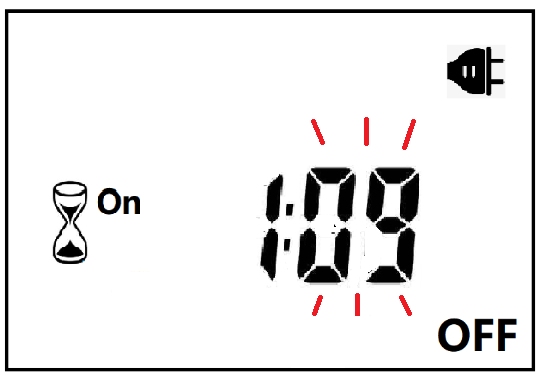

6. Press the [FUN" key to switch the working state in the following:
Set > Detected -> Detected > Set -> ON -> OFF
Set > Detected: Automatically switches when the detected ambient light intensity is darker than the set value
Detected >Set: Automatically switch when the detected ambient light intensity is brighter than the set value
When the brightness meets the setting conditions, the countdown starts as below:
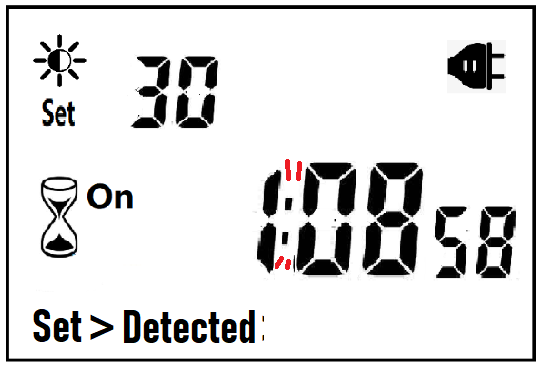
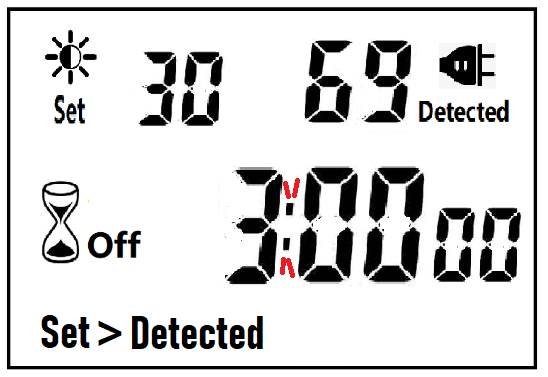
Note:when the countdown is ON, the detected value is not displayed.
When the brightness does not meet the setting conditions, the countdown stops and waits:
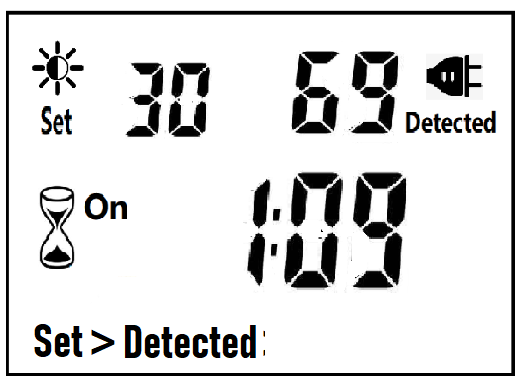
After the countdown ON is reduced to 0, the countdown OFF starts immediately and the power is OFF.
After the countdown OFF is reduced to 0:
A. If the light intensity meets the set conditions, a new round of countdown will be started;
B. If the light intensity does not meet the set conditions, keep the power off and wait for the light to meet the conditions before turning on automatically.
NOTE:
1. If the power is cut off while the countdown is running, the countdown will be terminated immediately and the relay output will be off. After the power is turned on again, a new round of brightness detection will start.
2. Modifying the brightness value in the countdown operation will not affect the current countdown operation. After the off time of the current countdown, the new brightness setting value will take effect.
3. In the countdown on operation, change the setting value of the countdown on, this countdown will still be timed according to the original setting value; the new setting value will take effect when the next countdown on starts.
4. In the countdown off operation, change the setting value of countdown off, this countdown will still be timed according to the original setting value; the new setting value will take effect when the next countdown off is started.
NOTE: the brightness setting value, countdown ON or countdown OFF, any one of which is equal to 0, cannot be switched ON or OFF automatically.
Manual Control
When ON or OFF is displayed, it means that the power supply remains ON or OFF, as shown in the figure below:

Power Detection and Standby Mode
With AC power supply, the icon ![]() lights up and works normally.
lights up and works normally.
When there is no AC power supply, the icon ![]() goes out, the brightness is not detected at this time, and the system enters the standby mode.
goes out, the brightness is not detected at this time, and the system enters the standby mode.
Photocell Timer, Photocell Timer Socket, Photocell Sensor, Photocell Sensor Socket, Sensor Plug, Sensor Switch Socket, Digital Photocell Timer, Digital Sensor Timer
NINGBO COWELL ELECTRONICS & TECHNOLOGY CO., LTD , https://www.cowellsockets.com